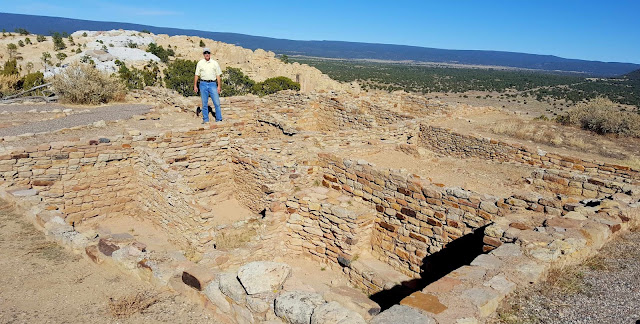We have never found a national park or national monument that we didn't enjoy, so we are glad to find two in our new neighborhood near Grants, New Mexico. We headed to El Morro National Monument today, and found out that these tall white cliffs are what makes it so special.
If we are going to explore events that happened at El Morro in chronological order, we're going to have to first climb all these steps to get to the top of those white rocks.
That brings us to a whole new world high above the desert plains below us.
It's up here that ancient Indian tribes built an entire city. In its heyday in 1275, it is estimated that 1,500 people lived here. After it was abandoned, the desert sand covered most of this hill-top town. In the 1950's an archaeology team uncovered a few of the 875 rooms built in this little city.
Nearby are the ruins of a larger round room with seating around the edges. We've visited enough Indian ruins to recognize a kiva--used for community gatherings and ceremonies.
It was fun wandering around the cliff-tops like the ancient Indians 800 years ago. Actually, we had a nice trail etched across the stone, complete with steps carved by the WPA in the 1930's.
We hiked all the way to the other side of the cliffs. Mark was taking a picture of the box canyon formed from this semi-circle of tall cliffs. He mentioned that we really needed a person in this picture, just to show how big these rock walls are. Denisa took that as a cue to circle back to where we had just walked. It's hard to see, but she's the dot on the opposite cliff in the top center of the picture below. If you don't see her, don't tell Denisa. She had to walk almost a mile to get there and back, and she didn't need all those extra steps on her pedometer today.
Our view from the top of the cliff shows the flat prairie that surrounds us. These tall white cliffs were easily seen for miles around, making them a landmark for many groups that would make their way across New Mexico. Many of them stopped for a while in the shadow of El Morro.
After our longer-than-needed hike on top of the cliffs, we headed back down to the prairie floor. A walkway runs right beside these white rocks that are now known as "Inscription Rocks."
For hundreds of years, travelers have been inscribing their presence onto this stone. Some of the earliest are the petroglyphs, pecked into the stone by the ancient people that lived in this area.
Fast forward to 1605, and we found one of the oldest and most famous of the inscriptions from the first governor of New Mexico. Fifteen years before the pilgrims landed at Plymouth Rock, the Spanish were exploring this area and leaving proof here on Inscription Rock.
In the 1800's, the U.S. military sent a unit to find a wagon route through this rugged landscape. Mr. Breckinridge was in charge of the 25 camels they brought with them. The camels were an experiment in military transportation, but eventually lost to the more readily-available mules. Based on the beautiful carving, Breckinridge and his camels spent much time here near El Morro in 1859.
The award for the most elegant inscription comes from another member of that military expedition. E. Penn Long of Baltimore, Maryland, must have known that travelers in 2017 would be staring at this wall more than 150 years later, appreciating his penmanship.
There are more signatures from miners and pioneers heading west beside this landmark. In fact, more than 2,000 carvings are on this great promontory in the desert. The thing that brought all those people here was the constant supply of water at the base of the cliffs.
Behind that fence is a deep pool fed by summer rains and winter snow. It's a constant source of water for the visitors that have camped here over the centuries.
We enjoyed our time wandering through the special pieces of history found here at El Morro National Monument. It's another of those lesser-known national facilities that provides a beautiful place to hike while learning more about our nation's history.
















Go to the Chaco Culture site! You're very close to it.
ReplyDelete